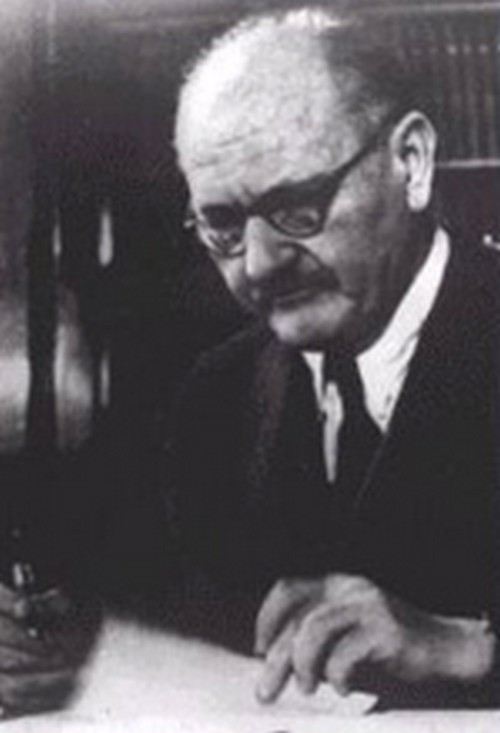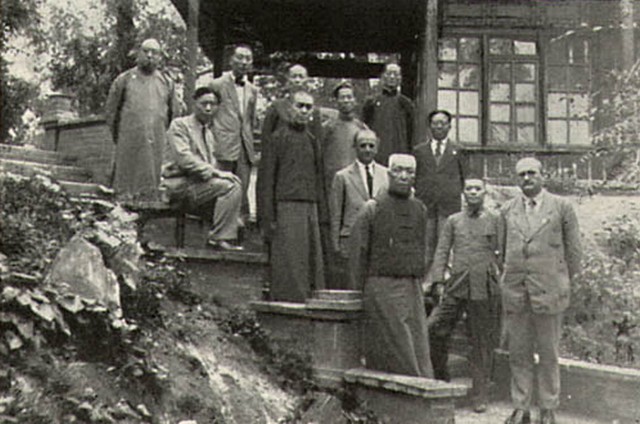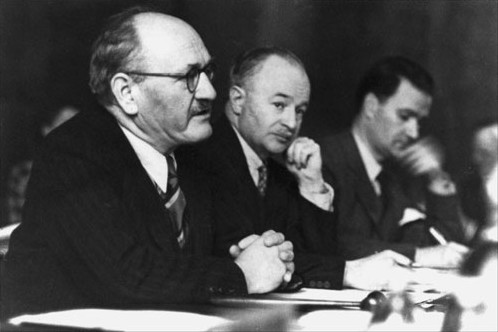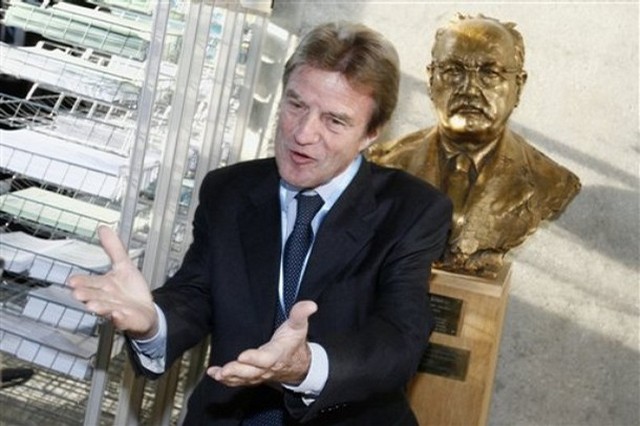 | Andrija Štampar (1888-1958), Croatian scientist and professor at the University of Zagreb, is the father of the World Health Organization, founded 60 years ago. He introduced the public health service in China in 1930s, where he spent three years as a specialist and representative of the then League of Nations. |


Andrija Štampar (on the right) in Lanchow, China, in 1930s, establishing public health service there.
| Professor Andrija Stampar (1888-1958), Croatian scientist and professor at the University of Zagreb, was our leading authority in the field of epidemiology and a pioneer in preventive medicine. As an expert of the League of Nations he spent three years (1933-1936) in China, developing the health service there. During the WW2 he was arrested by the German Nazis and kept in custody in Graz in Austria. He was one of the founders of the World Health Organization (WHO) and very active in promoting the health service in Afghanistan, Egypt, Sudan and Ethiopia. He wrote the introductory declaration of the Statute of the WHO and was the first president of this organization. In 1948 Andrija Stampar was the chairman of the first WHO General Assembly in Geneva. In 1955 he was awarded the medal of Leon Bernard, which is the most prestigious international acknowledgement in the field of social medicine. For more details see his book The first ten years of the World Health Organization, Geneva, 1958. Each year since 1993, during its Annual Conference, the Association of Schools of Public Health in Europe (ASPHER) awards the prestigious Andrija Stampar Medal to a distinguished person for excellence in the field of Public Health. For more details see Mirko Dražen Grmek: Andrija Štampar, provided by "Andrija Štampar" School of Public Health, Zagreb |

Štampar's famous definition of healthIn 1946, the new WHO constitution incorporated a definition of health proposed by the Croatian public health pioneer Andrija Stampar. It said health was "a state of complete physical, mental and social well-being and not merely the absence of disease or infirmity." This was a qualitative leap from earlier concepts, but it was difficult for many government experts of the time to fully grasp its meaning. Source: David A. Tejada de Rivero, Alma-Ata Revisited, Perspectives in Health , Vol 8, No 2, 2003 |

The Interim Commission met in Geneva in 1946. From left are Professor Andrija Štampar, a consultant to the commission and Dr Brock Chisholm, first Director-General of WHO.
| The historical roots of PHC (publich health care) can be found in Social Medicine, a discipline that emerged in Europe during the 19th century. One of its leading 20th century advocates was Dr Andrija Štampar, Croatian scientist, who, in fact, was deeply involved in the establishment of WHO (World Health Organization) to such a degree that he is often indicated to be the Father of WHO. Source: Socrates Litsios, WHO |
| Theodore M. Brown and Elizabeth Fee Andrija Stampar: Charismatic Leader of Social Medicine and International HealthAmerican Journal of Public Health, Vol 96, No 8, 2006Theodore M. Brown is with the Departments of History and Community and Preventive Medicine, University of Rochester, Rochester, NY. Elizabeth Fee is with the History of Medicine Division, National Library of Medicine, National Institutes of Health, Bethesda, Md. ANDRIJA STAMPAR, ONE OF the most charismatic and beloved figures in 20th century public health, was born in the village of Drenovac, Croatia, on September 1, 1888. His father was a schoolteacher who, because of his liberal views, had to move frequently to escape the consequences of his political convictions. Young Andrija absorbed his father's values and, though a brilliant student, sometimes came into conflict with his teachers when he asserted his right to be a "free thinker." After graduating from gymnasium in 1906, he enrolled at the University of Vienna Medical School. There he was attracted to Ludwig Teleky’s... Source: American Journal of Public Health |

Bernard Kouchner, of France, speaks with journalists about his candidacy for the post of the WHO Director General in front of a statue of Andrija Stampar, first president of the WHO assembly, during the first day of the World Health Organization WHO Executive Board meeting at the WHO headquarters in Geneva, Switzerland, on Monday, Nov. 6, 2006. From Nov. 6 until Nov. 8, 2006 the executive board meets in Geneva to decide on candidates, to interview them and then vote to propose a candidate to the World Health Assembly. In a special session on Nov. 9, 2006 the assembly will consider the board's nomination and will appoint a new director general to succeed late Lee Jong-Wook. (AP Photo/Keystone, Laurent Gillieron)

| ... From October 1931 till January 1932 Štampar stayed in the United States and Canada as the guest of the Rockefeller Foundation. The League of Nations also entrusted him with the task of acquainting himself with the work of a special American Committee dealing with the costs of medical care. From January to March 1993 he spent in China. The Health Organization sent him there as an advisor to help the Chinese health administration in the control of the mass infectious diseases which cropped up after devastating floods in 1931. In the spring of 1932, Štampar came back to Europe and worked at the Hygiene Committee in Geneva, of which he was elected Vice President. From the autumn of 1932 till the summer of 1933, as the expert of the Health Organization and in the capacity of a visiting professor, Štampar delivered a series of lectures at the European universities and Schools of Public Health. ... |

Wonderful recognition to Andrija Štampar, Croatian scientist, from the Central Chinese Government as a sign of their gratitude and appreciation.
| ... The Secretary General of the League of Nations, in a letter of August 30, 1933, asked Štampar to be 'the League expert on health matters to be put at the disposal of the Chinese Government in connection with the plan of technical cooperation with the League of Nations in the national reconstruction'. Štampar accepted this task and set ou immediately on the journey to Shanghai where he got in touch with the National Economic Council and the national health administration. The first region of Štampar's work was the province of Kiangsi which is situated in the southern part of China. Štampar prepared a detailed report on the economic and health conditions in this province and proposed a series of measures for the improvement of the living conditions of Chinese peasants. The chief point of Štampar's report on the province of Kiangsi was, no doubt, his request for an immediate implementation of agrarian reform. For the then Chinese rulers, Štampar's proposals were too revolutionary. During his stay in China, he also visited the provinces of Yunnan, Kwangsi and Szechwan. On leaving China, he was given two testimonials from the Central Chinese Government as a sign of their gratitude and appreciation. The text of one of these testimonials, written in the Chinese alphabet on a wonderful silk and coloured paper ground, runs in free translation as follows: 'Dr Štampar has come to China to help our Government in its work on reconstruction based on the plan of technical cooperation with the League of Nations. He went round several provinces, from Kansu and Shanghai in the West to Kwangtung and Kwangsi in the South, and made a valuable contribution to the reconstruction of our villages, especially in the field of rural health protection services. On his departure we wish to give this to him as a remembrance of his work in China, hoping he will come to visit us again. - Ching Feng' Source: "Andrija Štampar" School of Public Health, Zagreb; from an article by Mirko Dražen Grmek |

A letter of appreciation to professor Andrija Štampar from China.
| ...In August 1936, Štampar returned home, to Zagreb. The following year, four years after his first wife died, he married Dr Desanka Ristovic, a physician who distinguished herself as Head of the School Polyclinic in Zagreb and had been from the beginning one of the most faithful followers of Štampar's sociomedical ideology. The great understanding of his wife and their harmonious family life greatly helped Štampar in his future work. In 1936 he received an offer from the Secretary General of the League of Nations for the post of an expert at the Health Organization in Geneva. In 1938, he received an invitation from the Harvard University in Boston, and he delivered the Cutter lecture there. After Boston, at the invitation from the Rockefeller Foundation, he toured a great part of North America and lectured on hygiene and social medicine at a series of universities (Yale, Cornell, Johns Hopkins, Cincinnati, Vanderbilt, McHarry, Tulane, Texas, Los Angeles, Berkley, Portland, Minnesota, Toronto, McGill, Columbia, Galvestone). Source: "Andrija Štampar" School of Public Health, Zagreb; from an article by Mirko Dražen Grmek |

A letter of recognition sent by the League of Nations to Andrija Stampar in 1936 for his successful work on public health and social reconstruction in China.

Andrija Štampar (in the middle) in the USSR in 1936.
| Photos on this web page are a part of an exhibition devoted to Andrija Štampar, organized by the Croatian State Archives from July 8th to September 9th 2008. The author of the exhibition is Melina Lučić. It is accompanied by a booklet Andrija Štampar (40 pp) issued by the Croatian State Archives. |
Formated for CROWN by prof.dr. Darko Žubrinić
Distributed by www.Croatia.org . This message is intended for Croatian Associations/Institutions and their Friends in Croatia and in the World. The opinions/articles expressed on this list do not reflect personal opinions of the moderator. If the reader of this message is not the intended recipient, please delete or destroy all copies of this communication and please, let us know!
